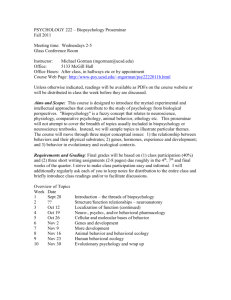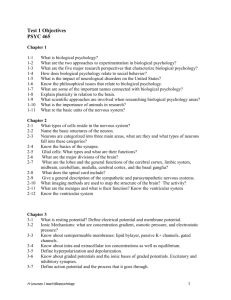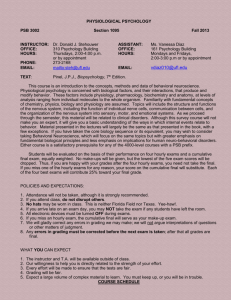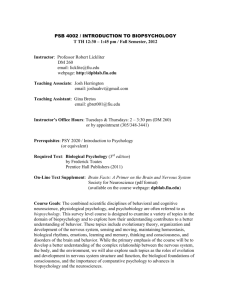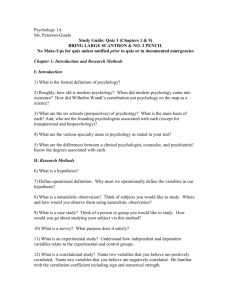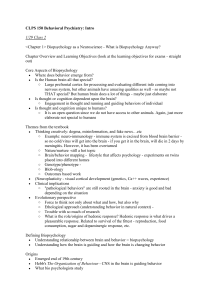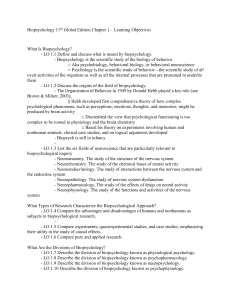Why study biopsychology?
advertisement
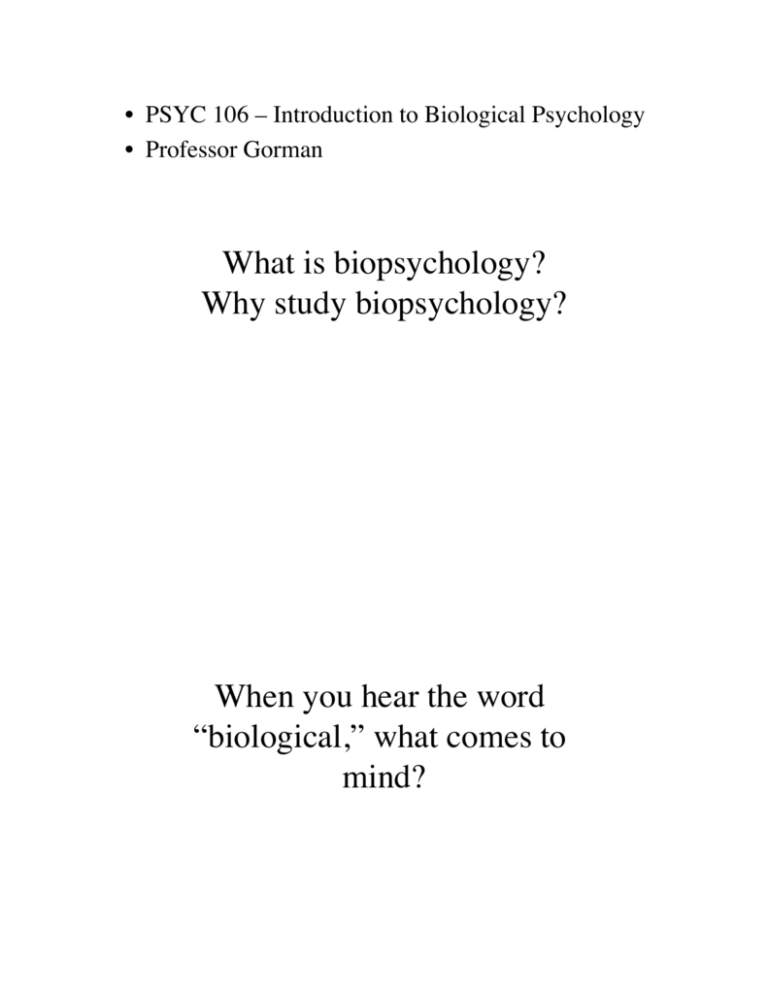
•! PSYC 106 – Introduction to Biological Psychology" •! Professor Gorman" What is biopsychology?! Why study biopsychology?" When you hear the word “biological,” what comes to mind?" MANTRAS" •! Biology is NOT determinism" •! Brains produce behavior AND behavior changes brains" •! Multiple approaches COMPLETE, don’t COMPETE" Anatomy –" Physiology – " Development – " Evolution – " Ecology – " Why do birds sing?" Why does your dog growl?" Why is someone dependent on alcohol?" Levels of Analysis: " Reductionism vs emergent properties (TRANS)" "How does bird learn song?" " "Through social interactions" " "Through hearing/brain" " "Through particular song nuclei" " "Looking at structure of these nuclei" " "Cellular mechanisms" " "Ionic mechanisms" •! Monisha Sullivan" •! Nadine Burke" •! Anda & Felitti (ACE)" •! Michael Meaney" •! Bruce McEwen" •! Is it surprising that childhood traumas are associated with higher rates of addiction?" •! Heart disease?" •! Cancer?" “Mechanisms” – HOW adverse experiences alter brain/body/mind?" •! Animal studies – fear/anxiety/hormones/ immune function/gene expression " •! Human studies try to confirm" Course Description: This course surveys the field of Physiological/Biological Psychology, an area of study concerned with physiological and evolutionary explanations of perception, cognition, and behavior. Because these functions depend on the nervous system, a major focus of the course will be on the structure and function of the brain with an emphasis on brainbehavior relations. Topics will include: evolutionary perspectives on brain and behavior, anatomy and development of the brain, neural signaling (neurotransmitters, drugs, hormones), and neural mechanisms of sensory processing, motor control (movement, action), motivated behavior (feeding, drinking), emotion, and learning and memory. Required Texts: Biological Psychology (10th Ed.) James W. Kalat, available at the bookstore Supplemental readings may be posted on the course website Optional Resources: Study Guide for Kalat's Biological Psychology Book website with quizzes http://www.wadsworth.com (follow links to the book psychology ! biopsychology etc.) Course Structure:" Fundamentals" Inputs -- Sensory Components" Outputs -- Motor/Movements" In-between -- Motivation/Cognition etc" Odds and Ends" Study Questions" •! Along what dimensions can the nervous system be usefully divided into smaller units, either functionally (i.e., in terms of how things work) or structurally (i.e., in terms of how it is built)? •! Why and how does Nadine Burke use assessments of adverse childhood experiences (ACEs) in her San Francisco medical clinic? •! Today 1.1, 4.1-4.3; New Yorker Article •! Next Class 1.2; 2.1-2.2 Fig. 2-1, p. 28! Fly, worm, bacterium?" 1-4 mm" Choi, BIOL PSYCHIATRY 2009;65:227–234" Summary" •! •! •! •! Structured -- Not homogeneous mush" Named descriptively" Function is localized but also distributed! Can identify structure/function (brain/ behavior) relationships" Study Questions" •! Along what dimensions can the nervous system be usefully divided into smaller units, either functionally (i.e., in terms of how things work) or structurally (i.e., in terms of how it is built)? •! Why and how does Nadine Burke use assessments of adverse childhood experiences (ACEs) in her San Francisco medical clinic?

